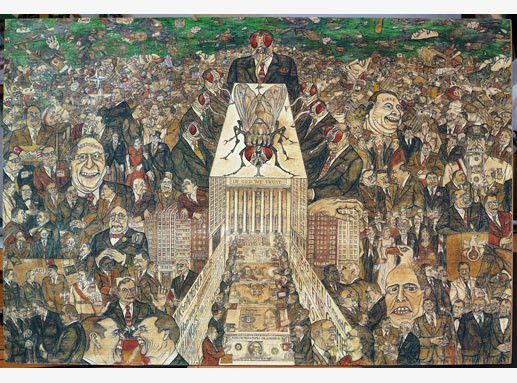Yüksel Arslan
20 Apr - 24 Jun 2012
YÜKSEL ARSLAN
Artures
21 April – 24 June, 2012
The Turkish artist Yüksel Arslan (born 1933, lives and works in Paris) left his native country in 1962 and settled in Paris where he has since generated an creative oeuvre in his home based in and on the reception of cultural, sociological, philosophical and artistic literature. The exhibition in the Kunsthalle Düsseldorf represents the first presentation of a selection of over 200 works on paper outside Turkey since 1959. The show focuses on the so-called Artures, paintings on paper produced in a unique technique with special paints. The works are marked by an expressiveness that Eugène Delacroix already described as a typical for the Orient or the Near East.
Their contents deal with the relationship of thought and mysticism, science and the visual arts while taking up philosophical, literary and musical currents that can be designated as the foundation of Western thought, knowing full well that the insights anchored here would probably never have come about without the empirical values of others peoples and cultures.
Arslan does not make use of classic paints for his works, mixing instead pigments from diverse herbal extracts, bodily fluids and other natural elements such as flowers and grass in addition to such substances as oil, coal and stones. This process is a central component in the development of the pictorial invention and does not represent a distinct preparatory part of the creative act. According to Arslan, the origins of painting have increasingly been neglected since modernism or, at the latest, since the introduction of industrially manufactured paints. Like Jean Dubuffet, the artist endeavours to cast off the ballast of the present in order to extract the true essence. Arlan can only rediscover the original via things that have seemingly been overcome by culture, but in fact have only disguised by it, for example procreation and sexuality. He is familiar with cultural “ballast” through his long occupation with modern and ancient languages, history, philosophy, music and traditional cultures. But Arslan has come to the recognition that much of this does not correspond to the true essence of the human being, and in the process, he pursues the similarities linking popular elements in the origins of cultures around the world.
The exhibition, which is presently on show at the Kunsthalle Zürich (28 January – 9 April 2012), can be seen afterwards at the Kunsthalle in Vienna. The comprehensive and opulently illustrated exhibition catalogue published by Hatje Cantz Verlag features texts by Elodie Evers, Jacques Vallet and Oliver Zybok and well as an interview with Yüksel Arslan by Beatrix Ruf.
Artures
21 April – 24 June, 2012
The Turkish artist Yüksel Arslan (born 1933, lives and works in Paris) left his native country in 1962 and settled in Paris where he has since generated an creative oeuvre in his home based in and on the reception of cultural, sociological, philosophical and artistic literature. The exhibition in the Kunsthalle Düsseldorf represents the first presentation of a selection of over 200 works on paper outside Turkey since 1959. The show focuses on the so-called Artures, paintings on paper produced in a unique technique with special paints. The works are marked by an expressiveness that Eugène Delacroix already described as a typical for the Orient or the Near East.
Their contents deal with the relationship of thought and mysticism, science and the visual arts while taking up philosophical, literary and musical currents that can be designated as the foundation of Western thought, knowing full well that the insights anchored here would probably never have come about without the empirical values of others peoples and cultures.
Arslan does not make use of classic paints for his works, mixing instead pigments from diverse herbal extracts, bodily fluids and other natural elements such as flowers and grass in addition to such substances as oil, coal and stones. This process is a central component in the development of the pictorial invention and does not represent a distinct preparatory part of the creative act. According to Arslan, the origins of painting have increasingly been neglected since modernism or, at the latest, since the introduction of industrially manufactured paints. Like Jean Dubuffet, the artist endeavours to cast off the ballast of the present in order to extract the true essence. Arlan can only rediscover the original via things that have seemingly been overcome by culture, but in fact have only disguised by it, for example procreation and sexuality. He is familiar with cultural “ballast” through his long occupation with modern and ancient languages, history, philosophy, music and traditional cultures. But Arslan has come to the recognition that much of this does not correspond to the true essence of the human being, and in the process, he pursues the similarities linking popular elements in the origins of cultures around the world.
The exhibition, which is presently on show at the Kunsthalle Zürich (28 January – 9 April 2012), can be seen afterwards at the Kunsthalle in Vienna. The comprehensive and opulently illustrated exhibition catalogue published by Hatje Cantz Verlag features texts by Elodie Evers, Jacques Vallet and Oliver Zybok and well as an interview with Yüksel Arslan by Beatrix Ruf.

